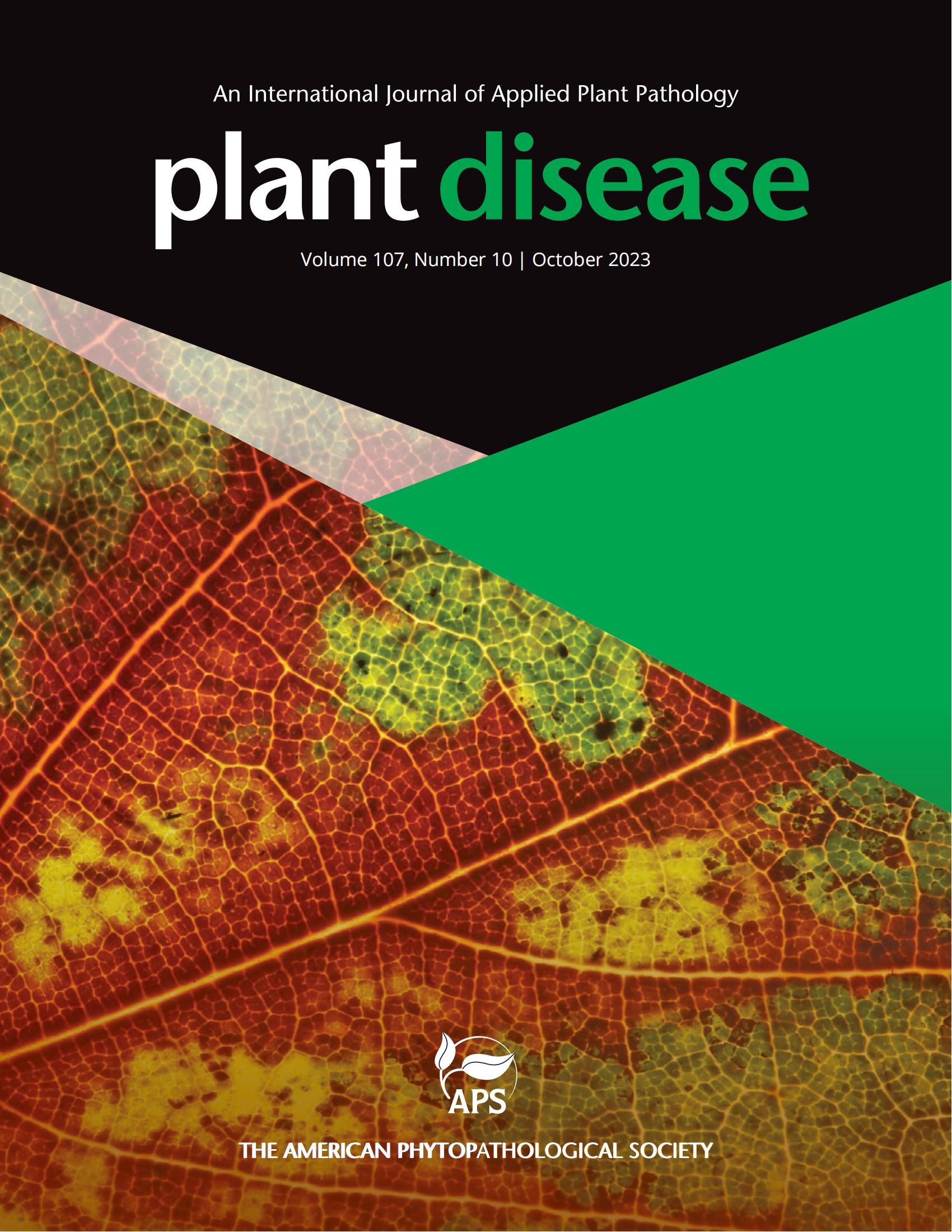阿肯色州和俄克拉何马州工业大麻(Cannabis sativa)上由麻孢子虫(Cercospora cf. flagellaris)引起的麻孢子叶斑病首次报道。
摘要
2021年秋季,在阿肯色州费耶特维尔的室外工业大麻(大麻sativa)地块观察到叶斑病。在俄克拉何马州阿代尔县的户外大麻地块中也观察到难以区分的症状。叶斑首先出现在下层冠层的老叶上,然后向上层冠层扩散。新生叶斑开始是黄绿色斑点,发展成直径2至4毫米的圆形坏死病灶,中心呈白色、褐色或灰色,边缘呈棕色。为了分离病原菌,收集成熟病变的绿叶,置于潮湿的室内。孵育24至72小时后,病变中出现了带有透明分生孢子的黑化、隆起的分生孢子。用无菌针采摘分生孢子,转移到V8琼脂+卡比西林(100 μg/ml)中。培养物在黑暗中25°C孵育。菌落为浅灰色或深灰色,菌丝为白色。一些菌落产生一种红紫色的色素,与头孢菌素一致。选取2株AR分离株(21CD76和21CD169)和3株OK分离株(21CD47、21CD52和21CD56)进行单孢子致病性试验和遗传鉴定。在V8琼脂上25℃暗箱培养,体外诱导孢子萌发。分生孢子透明,针状,直或稍弯曲,基部截形,顶端顶生,具不明显的隔,每分生5至15个。分生孢子长度在15 ~ 101 μm之间,与Cercospora cf. flagellaris (Chupp 1953)的描述一致。科赫的假设通过整株植物的接种得以实现。每个分离株的孢子用无菌水收集,稀释至105或106孢子/ml + 0.01% Tween 20。三周龄的cv。酸味太空糖和红十字用喷淋法接种至径流。阴性对照采用无菌水+ 0.01% Tween 20。每个品种每次处理4株。植物在潮湿的室内保存72小时,并在生长室内保持16/8小时的光/暗循环。7天后开始出现与现场所见症状一致的症状。14天后,所有接种植株均出现病变,而对照植株保持健康。鞭毛虫可从接种植株中分离到,但未从对照植株中分离到。致病性试验重复1次,结果相同。为了进行遗传鉴定,从全基因组序列中提取核糖体内转录间隔段(ITS)、翻译延伸因子1-α (TEF)、组蛋白H3 (HIS)、钙调蛋白(CAL)和肌动蛋白(ACT)基因片段或单独测序(GenBank: PV178994 ~ PV178998和PV335254 ~ PV335273)。BLAST查询结果显示,除PV335272序列外,其余序列与NCBI C. cf.鞭毛菌株的同源性均为99-100%,其中与NCBI C. cf.鞭毛菌株的同源性为97.76% (ITS: KX443947;Tef: mg975845, kx443988;型号:mg975843, kx443893;Cal: kx443808, kx443803, kx443809;行动:MG975837)。在MEGA12中建立了一个多位点系统发育(Kumar et al. 2024),该系统发育来自AR/OK大麻分离株、24株C. cf.鞭毛菌株、16株其他Cercospora spp和外群Septoria provencialis。所有五种AR/OK大麻分离株都与c.c.鞭毛虫属属,后者也在肯塔基州和佛罗里达州的大麻上引起Cercospora叶斑病(Doyle et al. 2019, Marin et al. 2020)。这是在AR和OK地区首次报道由c.c.f鞭毛菌引起的麻麻麻斑病,是目前已知的最西端发生该病的病例。In fall of 2021, a leaf spot disease was observed in outdoor plots of industrial hemp (Cannabis sativa) in Fayetteville, Arkansas. Indistinguishable symptoms were also observed in outdoor plots of hemp in Adair County, Oklahoma. Leaf spots first appeared on older leaves in the lower canopy before spreading to the upper canopy. Nascent leaf spots began as yellow-green specks and developed into round, necrotic lesions 2 to 4 mm in diameter with white, tan, or grey centers and brown boarders. To isolate the pathogen, green leaves with mature lesions were collected and placed in moist chambers. After incubation for 24 to 72 hrs, melanized, erumpent conidiophores bearing hyaline conidia emerged in lesions. Conidia were picked with a sterile needle and transferred to V8 agar + carbenicillin (100 μg/ml). Cultures were incubated in the dark at 25°C. Resulting colonies were light or dark grey with white aerial hyphae. Some colonies produced a reddish-purple pigment consistent with cercosporin. Two isolates from AR (21CD76 and 21CD169) and three isolates from OK (21CD47, 21CD52, and 21CD56) were single spored and selected for pathogenicity tests and genetic identification. Conidiation was induced in vitro by incubation on V8 agar at 25°C in the dark. Conidia were hyaline, needle shaped, straight or slightly curved, truncate at the base, terminal at the tip, with indistinct septa ranging from 5 to 15 per conidium. Conidium lengths ranged from 15 to 101 μm, consistent with descriptions of Cercospora cf. flagellaris (Chupp 1953). Koch's postulates were fulfilled via whole plant inoculations. Spores from each isolate were collected with sterile water and diluted to 105 or 106 spores/ml + 0.01% Tween 20. Three-week-old hemp plants of cv. Sour Space Candy and Red Kross were inoculated by spraying until run-off. Sterile water + 0.01% Tween 20 was used for negative controls. Four plants of each cultivar were used per treatment. Plants were kept in moist chambers for 72 hrs and maintained in a growth chamber with a 16/8-hr light/dark cycle. Symptoms consistent with those seen in the field began to appear after 7 days. After 14 days, all inoculated plants developed lesions, while control plants remained healthy. C. cf. flagellaris was reisolated from inoculated plants but not from control plants. The pathogenicity test was repeated once with the same results. For genetic identification, segments of the ribosomal internal transcribed spacer (ITS), translation elongation factor 1-α (TEF), histone H3 (HIS), calmodulin (CAL), and actin (ACT) genes were extracted from whole-genome sequences or sequenced individually (GenBank: PV178994 to PV178998 and PV335254 to PV335273). BLAST queries revealed 99-100% identity with NCBI C. cf. flagellaris strains for all but one sequence (PV335272), which shared 97.76% identity (ITS: KX443947; TEF: MG975845, KX443988; HIS: MG975843, KX443893; CAL: KX443808, KX443803, KX443809; ACT: MG975837). A multilocus phylogeny was created in MEGA12 (Kumar et al. 2024) with sequences from the AR/OK hemp isolates, twenty-four C. cf. flagellaris strains, sixteen other Cercospora spp., and Septoria provencialis as the outgroup. All five AR/OK hemp isolates grouped with C. cf. flagellaris, which has also caused Cercospora leaf spot on hemp in Kentucky and Florida (Doyle et al. 2019, Marin et al. 2020). This is the first report of C. cf. flagellaris causing Cercospora leaf spot on hemp in AR and OK, representing the westernmost known occurrence of the disease at this time.

 求助内容:
求助内容: 应助结果提醒方式:
应助结果提醒方式:


